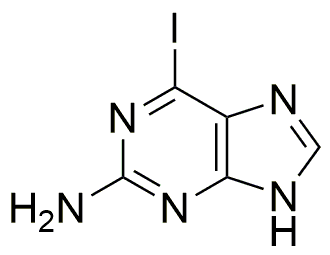2-Amino-6-iodopurine is widely utilized in research focused on
- Pharmaceutical Development: This compound serves as an important intermediate in the synthesis of antiviral and anticancer drugs, providing a basis for developing new therapies.
- Genetic Research: It is used in the study of nucleic acids, particularly in the development of modified nucleotides that can enhance the understanding of genetic mechanisms.
- Biotechnology: In the field of biotechnology, it aids in the design of novel biomolecules, contributing to advancements in genetic engineering and synthetic biology.
- Diagnostic Tools: The compound can be incorporated into diagnostic assays, improving the sensitivity and specificity of tests for various diseases.
- Research on Purine Metabolism: It is instrumental in studying purine metabolism, helping researchers understand metabolic disorders and develop targeted treatments.
General Information
Properties
Safety and Regulations
Applications
2-Amino-6-iodopurine is widely utilized in research focused on
- Pharmaceutical Development: This compound serves as an important intermediate in the synthesis of antiviral and anticancer drugs, providing a basis for developing new therapies.
- Genetic Research: It is used in the study of nucleic acids, particularly in the development of modified nucleotides that can enhance the understanding of genetic mechanisms.
- Biotechnology: In the field of biotechnology, it aids in the design of novel biomolecules, contributing to advancements in genetic engineering and synthetic biology.
- Diagnostic Tools: The compound can be incorporated into diagnostic assays, improving the sensitivity and specificity of tests for various diseases.
- Research on Purine Metabolism: It is instrumental in studying purine metabolism, helping researchers understand metabolic disorders and develop targeted treatments.
Documents
Safety Data Sheets (SDS)
The SDS provides comprehensive safety information on handling, storage, and disposal of the product.
Product Specification (PS)
The PS provides a comprehensive breakdown of the product’s properties, including chemical composition, physical state, purity, and storage requirements. It also details acceptable quality ranges and the product's intended applications.
Certificates of Analysis (COA)
Search for Certificates of Analysis (COA) by entering the products Lot Number. Lot and Batch Numbers can be found on a product’s label following the words ‘Lot’ or ‘Batch’.
Número de catálogo
Número de lote/lote
Certificates Of Origin (COO)
This COO confirms the country where the product was manufactured, and also details the materials and components used in it and whether it is derived from natural, synthetic, or other specific sources. This certificate may be required for customs, trade, and regulatory compliance.
Número de catálogo
Número de lote/lote
Safety Data Sheets (SDS)
The SDS provides comprehensive safety information on handling, storage, and disposal of the product.
DownloadProduct Specification (PS)
The PS provides a comprehensive breakdown of the product’s properties, including chemical composition, physical state, purity, and storage requirements. It also details acceptable quality ranges and the product's intended applications.
DownloadCertificates of Analysis (COA)
Search for Certificates of Analysis (COA) by entering the products Lot Number. Lot and Batch Numbers can be found on a product’s label following the words ‘Lot’ or ‘Batch’.
Número de catálogo
Número de lote/lote
Certificates Of Origin (COO)
This COO confirms the country where the product was manufactured, and also details the materials and components used in it and whether it is derived from natural, synthetic, or other specific sources. This certificate may be required for customs, trade, and regulatory compliance.


